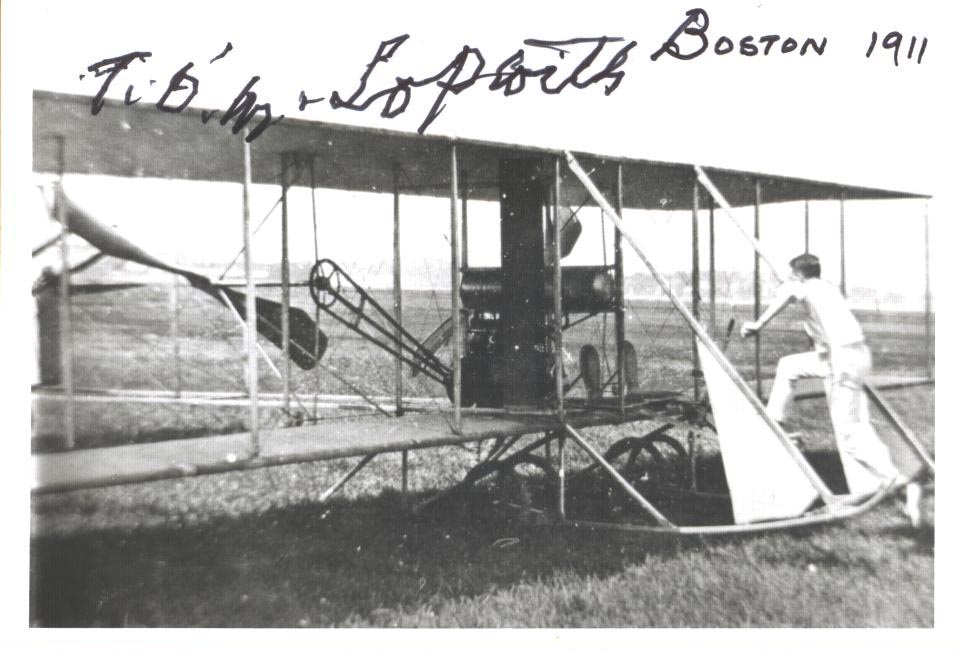

|
SOPWITH Thomas Sir
Sir Thomas Octave Murdoch Sopwith, CBE, Hon FRAeS (18 January 1888 – 27 January 1989) was an English aviation pioneer
Sopwith became interested in flying after seeing John Moisant flying the first cross-Channel passenger flight. His first flight was with Gustave Blondeau in a Farman at Brooklands. He soon taught himself to fly on a Howard Wright Avis monoplane and took to the air on his own for the first time on 22 October 1910. He crashed after travelling about 300 yards (275 m), but soon improved, and on 22 November was awarded Royal Aero Club Aviation Certificate No. 31, flying a Howard Wright 1910 Biplane.
On 18 December 1910, Sopwith won a £4000 prize for the longest flight from England to the Continent in a British-built aeroplane, flying 169 miles (272 km) in 3 hours 40 minutes. He used the winnings to set up the Sopwith School of Flying at Brooklands.
In June 1912 Sopwith with Fred Sigrist and others set up The Sopwith Aviation Company. The company produced more than 18,000 British World War I aircraft for the allied forces, including 5747 of the famous Sopwith Camel single-seat fighter. Sopwith was awarded the CBE in 1918.
Bankrupted after the war by punitive anti-profiteering taxes, he re-entered the aviation business a few years later with a new firm named after his chief engineer and test pilot, Harry Hawker. Sopwith became chairman of the new firm, Hawker Aircraft.
After the nationalization of what was by then Hawker Siddeley, he continued to work as a consultant to the company until 1980.
He became a Knight Bachelor in 1953.
Sopwith's 100th birthday was marked by a flypast of military aircraft over his home. He died in Hampshire on 27 January 1989, aged 101
From Wikipedia, the free encyclopedia
The airplane that finally brought down the Red Baron, Manfred von Richtofen, was an English biplane called the Sopwith Camel. It was a maneuverable little plane. My father, who flew them in France, told me they were tricky to fly. But with a good pilot, they were deadly in combat. In 1917, the Germans owned the air over the Western front. Then, that summer, the Sopwith Camels arrived. And control of the air shifted back to the allies.
It was called the Camel because the contour of its fuselage included a humplike cowl over the guns, in front of the pilot. And Sopwith referred to its maker, Thomas Octave Murdoch Sopwith.
The WW-I air war was, in large measure a duel between Sopwith and the maker of German airplanes, Fokker. Sopwith learned to fly in 1910, when he was twenty-two. By then, he'd raced automobiles and speedboats, and he'd done daredevil ballooning. In no time, he won flying prizes and used the prize money to start making airplanes. Like Fokker, he was a young airplane maker, ready for World War I.
During the war, he built 18,000 airplanes for the British. His early Sopwith Pup and Sopwith Triplane, along with the French Nieuports, dominated the air until 1916 when the Fokker Triplane appeared. But then the Camel reclaimed Allied air superiority.
Both Sopwith and Fokker were still under thirty in the fateful summer of 1917. Fokker came out with the superior Fokker D-VII in 1918, and he momentarily gave the game back to Germany. But then the French Spad and England's Sopwith Snipe restored Allied dominance. The Snipe became the mainstay of British air power for a decade after the war. The young Thomas Sopwith had done a remarkable job by any measure.
He stayed with airplane building after the war. In 1935 he was made Chairman of the Hawker-Siddley group, and there he did a remarkable thing. In 1936 he decided to produce a thousand Hawker Hurricanes on his own, without a government contract. War was brewing again, and if the government wasn't ready, Sopwith was. Without the Hurricane, England would've been laid bare against Nazi bombers in the early days of the Battle of Britain.
But even that was far from the last of Sopwith. After World War II, his company developed the Hawker Harrier -- the first jet airplane that could take off and land vertically. The Harrier was prominent during the Falklands War.
Sopwith celebrated his hundredth birthday on January 18th, 1988. The RAF sent flights of Sopwith's airplanes past his home near London. What a history lesson that was! An array of airplanes from early flying machines to modern jets -- a parade that called up the whole history of powered flight in the life of one man. For Sopwith had a perfectly uncanny ability to read the future. He died, by the way, a year later at the age of 101.
John Lienhard, at the University of Houston,
Signed photo 4 ½” x 6 ½”
Price: $90.00
Please contact us before ordering to confirm availability and shipping costs.
Buy now with your credit card
other ways to buy
|


